Caballero B. (ed.) Encyclopaedia of Food Science, Food Technology and Nutrition. Ten-Volume Set
Подождите немного. Документ загружается.


with single bonds vibrate below 1500 cm
1
. Stretch-
ing vibrations change bond lengths, and deformation
vibrations change bond angles. They occur at
approximately half the stretching frequency.
0005 According to quantum mechanics, vibrations are
excited by energy quanta, hn
s
, where h is Planck’s
constant, and n
s
is the vibrational frequency. Radi-
ation quanta in the infrared range, 2.5–1000 mm,
equivalent to 4000–10 cm
1
, can be absorbed by the
molecule and excite it from the vibrational ground
state (v=0) to the vibrational excited state (v=1).
Thus, absorption bands are produced in the infrared
spectrum (Figure 2a).
0006 If the molecules are irradiated with quanta of the
near-infrared range, 0.8–2.5 mm, equivalent to
12 500–4000 cm
1
, the overtones and combination
bands of the infrared spectrum, especially, of the
CH, NH, and OH bonds are excited, giving rise to
the near-infrared spectrum.
Near infrared
0007 When the molecules are irradiated with quanta of
large energy, hn
0
(by monochromatic, usually laser,
radiation from the ultraviolet, visible or near infrared
region), a scattering process may occur, by which
vibrations with energy hn
s
are excited and quanta of
lower energy, hn
R
¼ hn
0
hn
s
, are emitted simultan-
eously. These constitute the so-called Raman
spectrum (Figure 2b). The quantum yield of Raman
scattering is quite low (10
12
), this means that
Raman spectra are of a low intensity. If there are
samples with absorption bands that can be excited
by the quanta hn
0
, then fluorescence may occur, a
strong emission spectrum with broad bands
(Figure 2c). Since the quantum yield for this process
is nearly 1, Raman spectra can be completely con-
cealed, even when the concentration of the fluores-
cing impurities is very low. Until 1986, Raman
spectroscopy with excitation in the visible region
was only rarely applied to food analysis, since the
spectra were heavily masked by the fluorescence
spectra of some natural compounds: cells can only
live with the help of an enzymatic machinery
with absorption bands in the visible range of the
spectrum – consequently, it shows fluorescence and
is photochemically endangered. Raman spectra of
most food products therefore cannot be investigated
with ‘classical’ excitation in the visible range. How-
ever, when Raman spectra are excited in the near-
infrared range, e.g., with 1064 nm, the energy of
the quanta, hn
0
, is too small (only about half of
the quanta at 488 nm) to excite fluorescence
(Figure 2c). Excitation with the Nd:YAG laser at
1064 nm marks an optimum for non-destructive
recording of the Raman spectra of living cells and
all kinds of food.
0008The intensities of the vibrations revealed by the
infrared spectrum are proportional to the square of
the change of the molecular dipole moment, m, during
the vibration, described by the ‘normal coordinate,’
q. The intensity of the Raman spectrum is propor-
tional to the square of the change of the molecular
polarizability, a, during the vibration:
Infrared intensity
qm
qq
2
:
Raman intensity
qa
qq
2
:
The polarizability characterizes the elastic deform-
ation of the charge distribution of a molecule by an
electric field. Therefore, infrared spectra usually
show strong bands for vibrations of polar groups.
Raman spectra, however, show strong bands for
vibrations of nonpolar and multiple bonds as well
L
(a)
L
SC
N
RA
(b)
L
HK
L
TT
N
RA
fig0004Figure 4 Entrance optics for an NIR-FT-Raman spectrometer:
(a) SC sample cup with CaF
2
window and a VITON O-ring, L beam
of a Nd:YAG laser; (b) the sample in a small test tube, TT, in the
center of a hemispherical mirror HK. The exciting radiation,
diffusely scattered by the sample is reflected by the notch filter
N; together with HK this multiple reflection arrangement
enhances the intensity of the observed Raman spectrum and
integrates the spectra of the whole sample.
SPECTROSCOPY/Infrared and Raman 5417
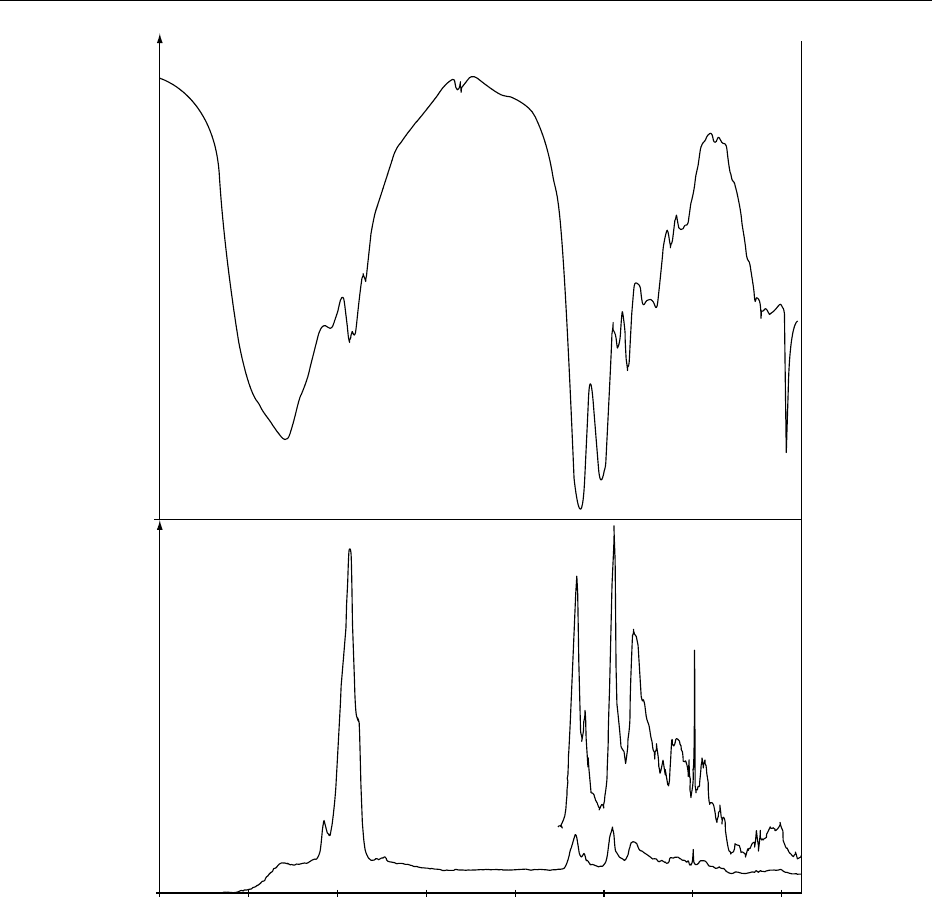
as for symmetric vibrations of collections of similar
bonds, as in ring systems.
Typical Features of Infrared and Raman
Spectra
0009 In Table 1, typical properties of the methods of vibra-
tion spectroscopy are collected. In several aspects,
Raman spectroscopy has several advantages com-
pared with infrared spectroscopy: it needs only
very simple or no preparation, uses nonproblematic
sample containers, and needs only one spectrometric
set-up for the whole spectrum. In particular, the
intensity of the bands is proportional to the concen-
tration. Unfortunately, Raman spectrometers are at
present more expensive than the infrared instruments.
The properties of the near-infrared spectrometry are
also listed, for comparison.
0010Table 2 lists the assignment of the bands that can
be observed using both methods. Vibrations of
polar groups are more intense in the infrared spec-
trum, whereas multiple bonds and symmetric
4000
Infrared transmissionRaman intensity
3500 3000
n(CH)
n(NH)
n(CH)
Amide I
Amide I
Amide II
Amide III
Phe
Tyr
Trp
n(=CH)
δ(CH)
2500
Wavenumber (cm
−1
)
2000 1500 1000 500
fig0005 Figure 5 Infrared and Raman spectra of bovine serum albumin. n, mean stretching vibration; Phe, Tyr and Trp mark typical
vibrations of amino acids.
5418 SPECTROSCOPY/Infrared and Raman
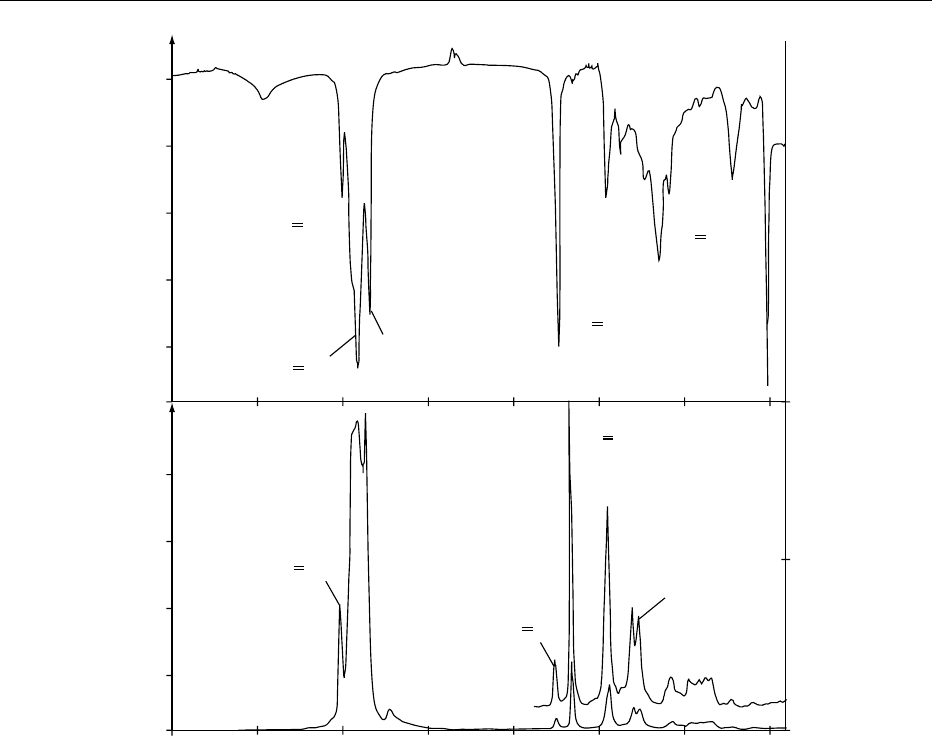
vibrations are usually more intense in the Raman
spectrum. Therefore, it is often useful to evaluate
both spectra.
0011 Every molecule is a vibrating unit. If it contains
n atoms, it has 3n 6 ‘normal vibrations.’ Together,
they represent a unique fingerprint, allowing the
identification of the molecule. For example, Figure 3
shows the infrared spectra (above) and the Raman
spectra (below) of eight important food components.
0012 The spectra of the cystine molecule (Figure 3a)
shows many bands with the same frequencies in the
infrared and the Raman spectrum. However, the in-
tensities clearly demonstrate the nature of the groups
responsible: vibrations of polar groups are strong in
the infrared. The bands due to the COOH and NH
2
groups with participation of zwitterionic COO
and
NH
3
þ
groups are strong and broad in the infrared spec-
trum at 3000 and 1600–1400 cm
1
, but they are weak
in the Raman spectrum. Conversely, the stretching
vibrations of the CH
2
group at 2917 and 2969 cm
1
and especially the S—S stretching vibration at
499 cm
1
are very strong in the Raman spectrum.
0013In Figure 3b, the spectra of linolenic acid methyl
ester are shown. The ester C
—
—
O group (1743 cm
1
)
produces a strong infrared and a weak Raman band;
the C
—
—
C group (1654 cm
1
), however, shows a very
strong Raman and a very weak infrared band. These
are useful for the determination of the unsaturated
fatty acids in fats (see below).
0014The spectra of retinol, vitamin A (Figure 3c) show
the typical vibrations of the conjugated C
—
—
C bonds
at 1586, 1193, and 1155 cm
1
, strong in the Raman
and weak in the infrared spectrum.
0015In Figure 3d and 3e, the spectra of caffeine and
vitamins B
1
show many strong and sharp bands,
typical for nonflexible ring systems.
4000
Wavenumber (cm
−1
)
3500
Raman intensity Infrared transmission
3000 2500 2000 1500 1000 500
n( CH)
n
a
( CH
2
)
n
s
(CH
2
)
n(C O)
w(CH
2
)
t(CH
2
)
n(C O)
n(C 0)
n(C 0)
d(CH
2
)
d(CH
2
)
n( CH)
fig0006 Figure 6 Infrared and Raman spectra of safflower oil. n, d, o and t mark stretching, deformation, wagging and twisting vibrations.
Note the high intensity of the n (C = C) in the Raman spectrum.
SPECTROSCOPY/Infrared and Raman 5419
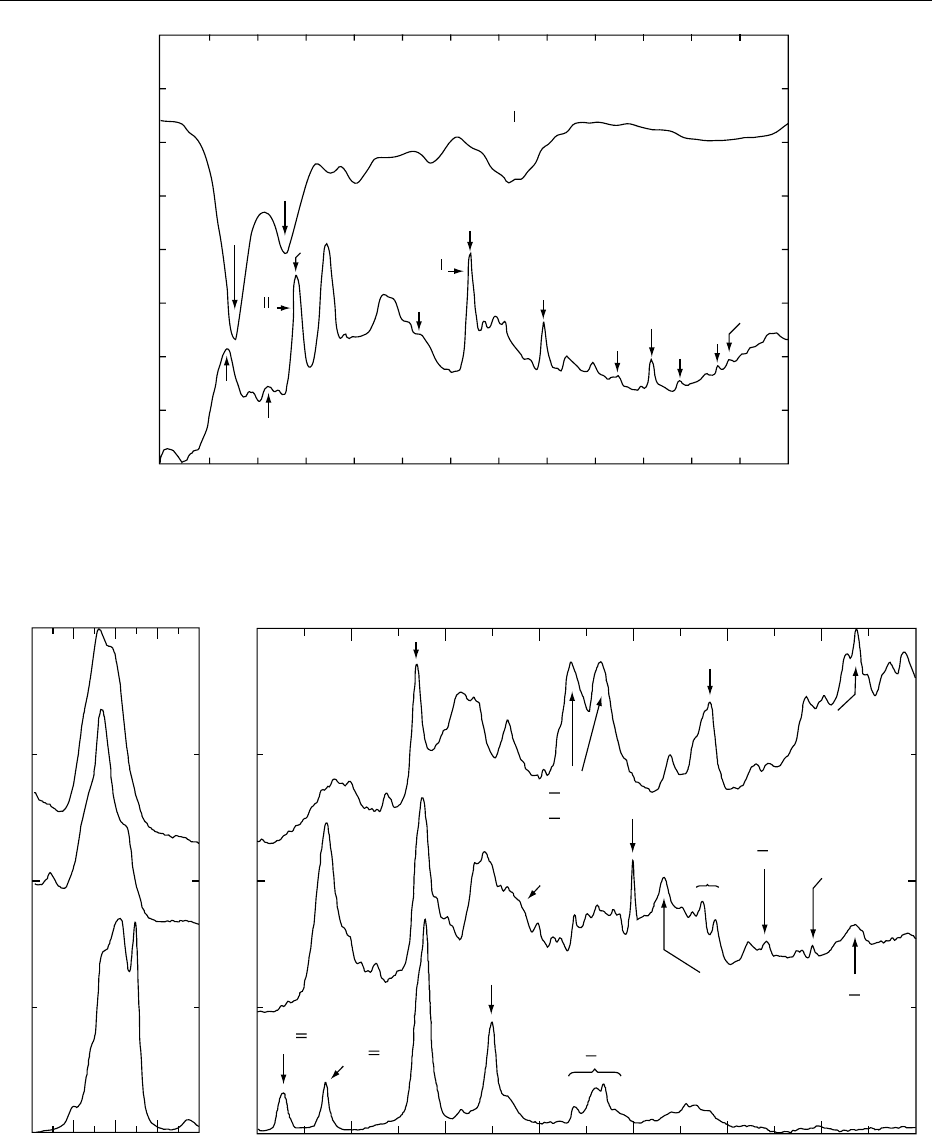
0016 Figure 3f, g, and h show the spectra of carbo-
hydrates: vitamin C, glucose, and sucrose. All show
strong bands in the range 1200–1000 cm
1
, due to
the C—O groups. Hydrogen-bonded O—H groups
show bands around 3400, and ‘free’ OH bonds
above 3500 cm
1
.
Wavenumber (cm
−1
)
Raman intensity
IR transmission
1800 1600
Amide I
Amide I
Amide II
Amide III
A,G
n(C C)
n(C O)
Phe
Tyr
Trp
Tyr
Phe
C,U,T
1514
1155
1400
(b)
(a)
1200 1000 800 600 500
n(C C)
fig0007 Figure 7 (a) Infrared and (b) Raman spectrum of Micrococcus roseus. C, cytidine; U, uridine; T, thymidine; A, adenosine;
G, guanosine.
Amide I
Phe
1654
Phe
Tyr
Amide III
Protein, skeletal
backbone
n(C C)
n(C N)
+
t (CH
2
)
n(C O)
n(C C)
n(C C)
+
n(C O)
n(S S)
(a)
(b)
(c)
(a)
(b)
(c)
Raman intensity
1800270029003100 1600 1400 1200 1000 800 600 400
Wavenumber (cm
−1
)Wavenumber (cm
−1
)
fig0008 Figure 8 Raman spectra of typical components of food: (a) banana (carbohydrate); (b) turkey breast (protein); (c) butter (lipid).
5420 SPECTROSCOPY/Infrared and Raman
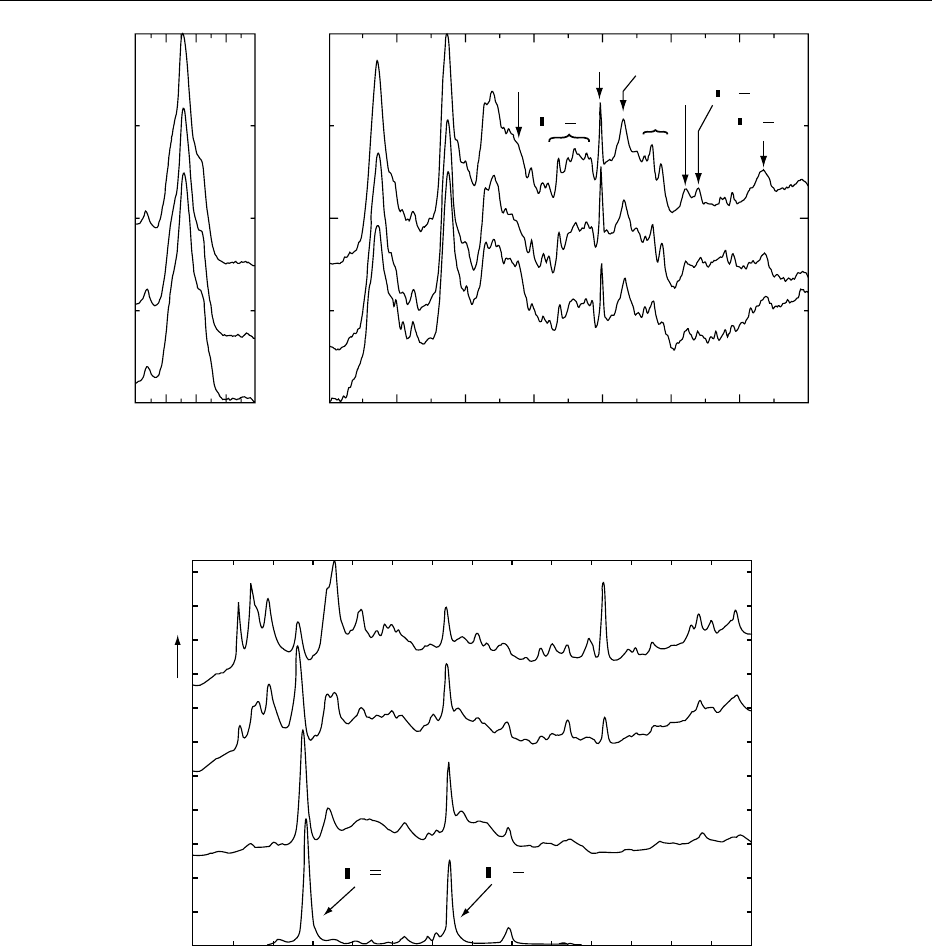
0017 Identification is made easy by comparison of
the observed spectra with those in atlases of Raman
and infrared spectra of organic and inorganic
compounds and by collections of digitized spectra
supplied by the instrument manufacturers.
Quantitative Analyses
0018 The basic relation for quantitative analyses by infra-
red absorption spectroscopy is the Beer–Lambert law:
F ¼ F
0
10
ecl
¼ F
0
10
A
:
Here, F
0
is the radiant power illuminating the
sample, and F is the transmitted power. The transmit-
tance of the sample, t ¼ F=F
0
, is usually recorded, e is
the molar absorption coefficient, c is the concentra-
tion and l is the absorbing path length. Most instru-
ments allow quantitative analyses by recording
the absorbance, A, which is proportional to the
concentration.
1800 1600 1400 1200 1000 800 600 400
Wavenumber (cm
−1
)
Raman intensity
(a)
(b)
(c)
(d)
(C C)
(C C)
n
n
fig0010 Figure 10 Raman spectra of food components containing carotinoids: (a) peel of untreated orange; (b) peel of orange, treated with
wax and fungicides; (c) carrot; (d) b-carotene.
3100 2900
Wavenumber (cm
−1
)
Raman intensity
Wavenumber (cm
−1
)
2700
1800 1600 1400
Amide I
(a)
(b)
(c)
(a)
(b)
(c)
Amide II
Phe
93
Tyr
Trp
(C C)
1200 1000 800 600 400
(C N)
(S S)
fig0009 Figure 9 Raman spectra of fresh meat of (a) turkey, (b) pork, and (c) beef.
SPECTROSCOPY/Infrared and Raman 5421
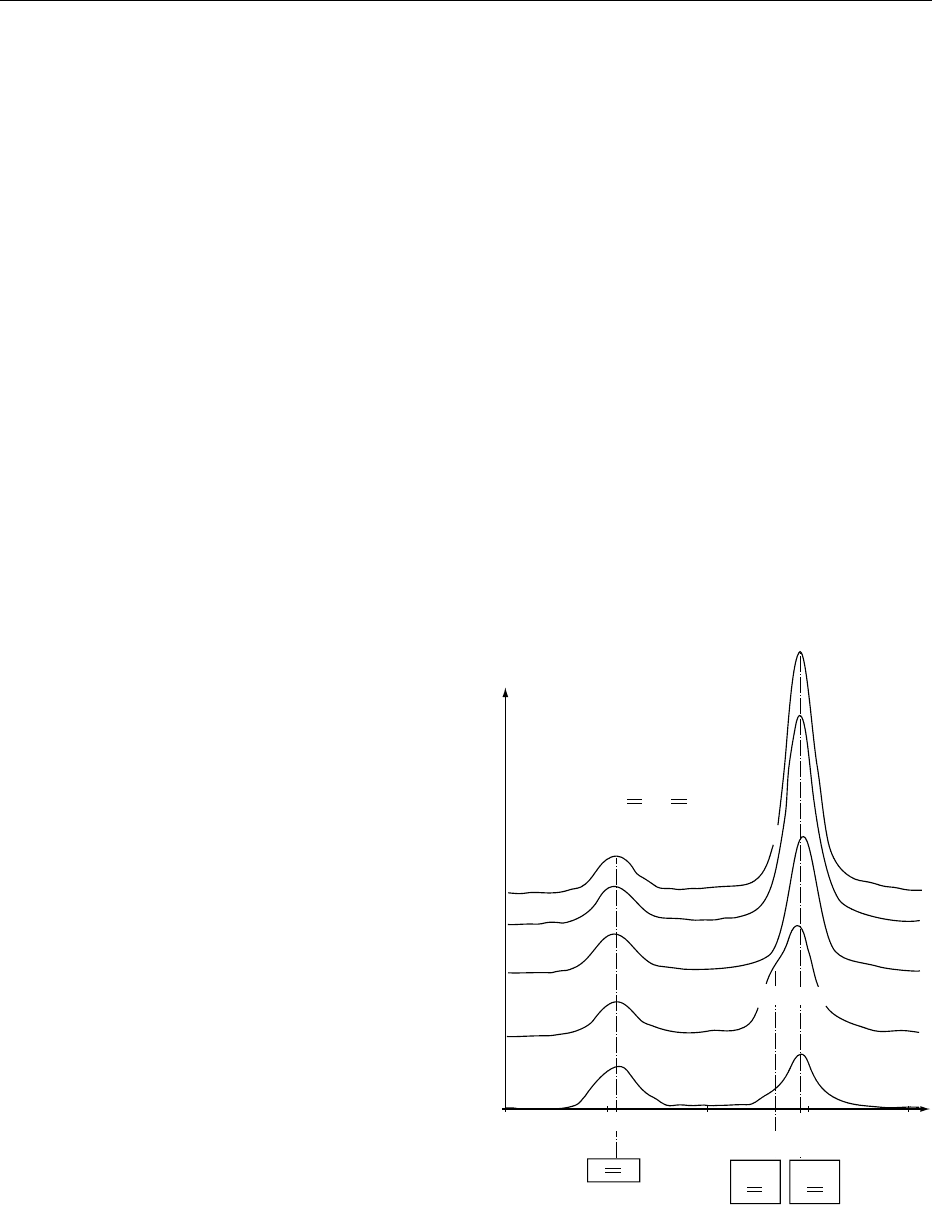
0019 The intensity of Raman lines is proportional to the
concentration over several orders of magnitude. Non-
linearities due to intermolecular interactions can be
taken into account by calibration curves determined
under conditions similar to those of the practical
application. Depending on the circumstances, ‘inten-
sities’ are measured at the maximum of a band or by
integration of the band contour. The analysis of
spectra is supported by the use of sophisticated multi-
component analysis, e.g., cluster analysis or neuronal
networks.
Special Techniques
Infrared Spectroscopy
0020 For infrared spectroscopy, the common technique
uses sample cells with a lamella of a liquid sample of
a path length between 5 and 20 mm or a solution of
about 100–500 mm, the transmittance of which is
measured as a function of the wavenumber. The la-
mella is supported by infrared-transparent windows,
mostly of (hygroscopic(!)) potassium bromide (KBr).
However, solid samples need special preparation.
They can be mixed with KBr powder and pressed
into disks, or they can be ground together with an
infrared-transparent oil.
0021 The so-called ‘attenuated total reflection’ (ATR) or
‘frustrated multiple internal reflection’ (FMIR) tech-
nique is especially useful for food analyses by infrared
spectroscopy. An infrared beam coming from a ma-
terial with a large refractive index is totally reflected
at a surface adjacent to a sample having a smaller
refractive index. Under the conditions of total reflec-
tion the beam emerges into the adjacent medium as
‘evanescent wave’, thus being partially absorbed by
infrared active vibrations. The ATR technique can
be used for samples which are difficult to prepare
such as meat, cheese, vegetables or dressings.
Especially as ‘circle cell’ this technique is specially
designed for continuous analyses of flowing liquids
such as alcoholic beverages, syrups or milk products.
0022 Powdered materials can be investigated by the ‘dif-
fuse reflection’ method. By making use of multiple
reflections of the infrared beam by the powder,
components in even very low concentrations may
be detected. Analysis of samples on thin-layer chro-
matography (TLC) plates is possible directly after
extraction. (See Chromatography: Thin-layer Chro-
matography.)
0023 Investigation of volatile components is possible by
coupling of an infrared spectrometer to a gas
chromatograph either by making use of internally
reflecting glass capillaries as sample cells or by con-
densing the fractions on a cooled infrared-transparent
support. Aroma components are determined in this
way by headspace analyses. Trace analyses of toxic
components in gases, e.g., in human breath, employ
cells with mirror systems (White cells) allowing large
effective path lengths by multiple pass of the beam.
(See Chromatography: Gas Chromatography.)
0024Infrared microscopes are now available, which
employ the properties of reflecting objectives having
no chromatic aberration. The samples can therefore
be adjusted in the beam by inspection with visible
light, and afterwards, the infrared spectra in either
transmission or reflection can be run from exactly the
same spot. The spatial resolution of infrared micro-
scopes is limited by the wavelengths of the radiation
employed and is of the order of 50 mm.
Raman Spectroscopy
0025The new FT Raman spectrometers usually observe
the spectra of samples with a 180
geometry. This
means that the exciting radiation is directed on to
the sample perpendicularly to its surface. The Raman
radiation emerging from the surface is collected with
1800 1700
Trans
C C
Cis
1600
Butter (1.25)
Raman intensity
Olive oil (3.20)
Sunflower Oil (4.79)
Safflower oil (C C/C O = 5.56)
C O
C C
Sunflower margarine (2.99)
1650
Wavenumber/cm
−1
1750
fig0011Figure 11 Raman spectra of different fats: (a) safflower oil; (b)
sunflower oil; (c) olive oil; (d) sunflower margarine; (e) butter. All
spectra are normalized to the intensity of the C
—
—O vibration at
1746 cm
1
. The trans-C
—
—C is at 1662, and cis-C
—
—C at 1653 cm
1
.
Intensity ratio of cis-C
—
—C to C
—
—O for (a) 5.56, (b) 4.79, (c) 3.20,
(d) 2.99 and (e) 1.25.
5422 SPECTROSCOPY/Infrared and Raman
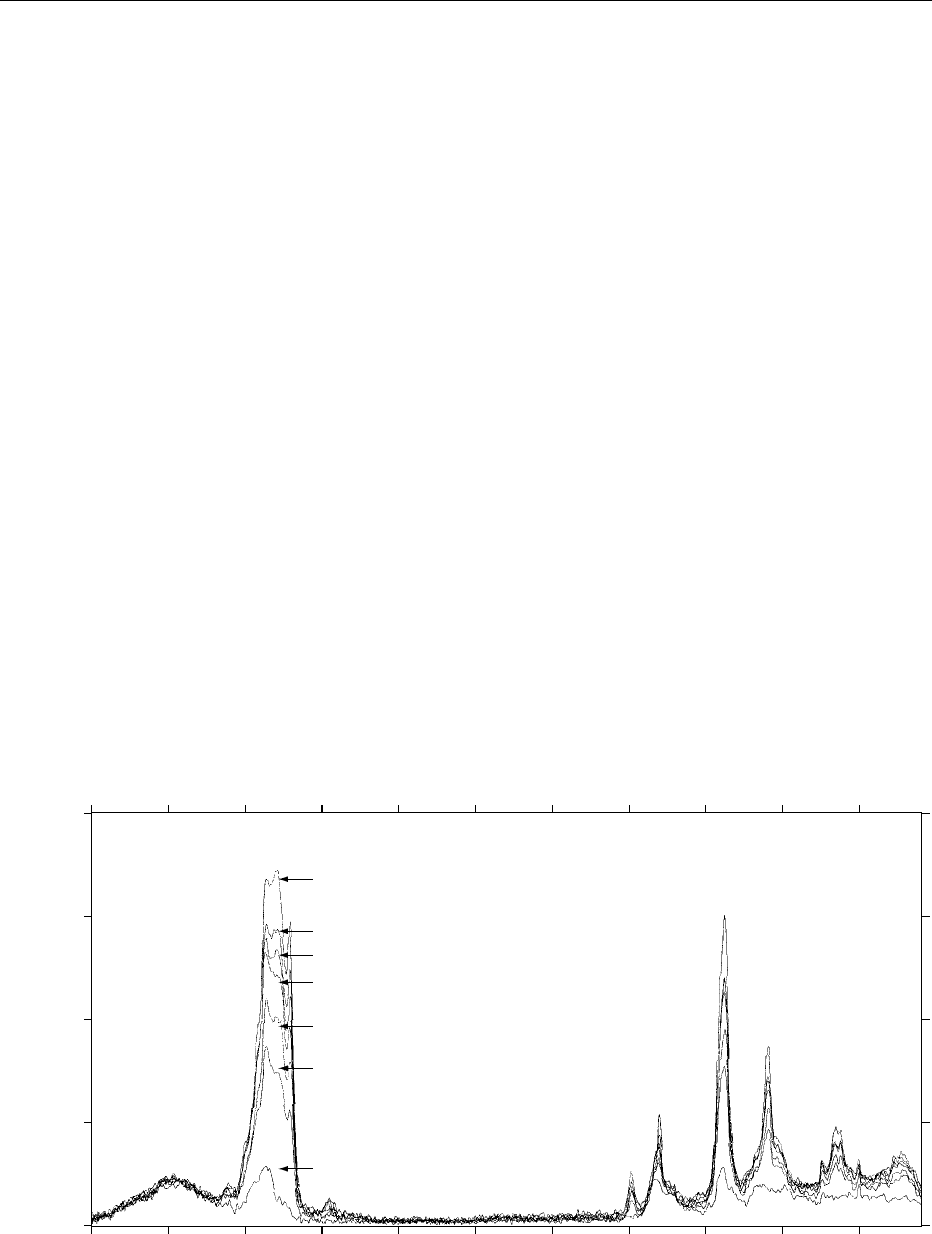
a lens system with a large aperture. The samples
are analyzed in cells, allowing multiple reflection
(Figure 4). The amount of sample is about 100 mg,
but 1 mg of a liquid or solid sample in a melting-point
tube is often sufficient; much less is needed when a
Raman microscope is applied.
0026 The Raman spectra were usually recorded with the
Bruker FT-Raman spectrometer (IFS 66 with FRA
106) and a resolution of 4 cm
1
, 350 mW of laser
power at 1064 nm with unfocused beam, and a
recording time of 15 min.
0027 Fiber-optical systems are especially useful for
food analyses by Raman spectroscopy. They connect
the spectrometer with a remote sample. Optical
fibers may have a very high transmittance in the
near-infrared range (about 80% per kilometer), and
therefore an analysis of remote process streams of
powders or fluids is possible, even of the content of
reactors.
0028 A microscope for recording of FT-Raman spectra
of small particles or inclusion is commercially avail-
able as an accessory to the instruments. It is coupled
by fiber optics to the spectrometer, which may be
placed at some distance. Raman spectra of tissues,
microorganisms and fibers, often complementary to
infrared microscopy, can be investigated. One advan-
tage of Raman microscopy is its greater spatial
resolution of the order of 5 mm.
Selected Applications
0029Figure 5 shows the infrared and Raman spectra of
bovine serum albumin. The typical vibrations of the
amide groups of proteins can be seen in the infrared as
well as in the Raman spectra (Table 2). (See Amino
Acids: Determination.)
0030Figure 6 shows the spectra of safflower oil. As
mentioned in the discussion of Figure 3b, the esters
of unsaturated fatty acids show complementary in-
tensities of the C
—
—
O and the C
—
—
C stretching vibra-
tions in the IR and Raman spectra. (See Fatty Acids:
Analysis.)
0031Microorganisms can be characterized by Raman as
well as infrared spectroscopy. Employing multivariate
statistical analysis of the second derivative of the
spectra, different strains of bacteria can be classified.
With FTIR and especially near infrared FT Raman
microscopes the identification of bacteria, viruses,
fungi, and even mammalian cells is possible (Figure 7).
0032As already discussed with Table 1 for several appli-
cations, Raman spectroscopy is better than infrared
spectroscopy. This is partially due to the fact that the
water content of food shows a very strong absorption
in the infrared range and also, since, for Raman
spectroscopy, only minimal sample preparation is
necessary. Therefore, the examples discussed below
concentrate on NIR-FT-Raman spectra.
3500
0.0000
0.0025
0.0050
0.0075
0.0100
Wavenumber (cm
−1
)
Raman units
3250 3000 2750
(a)
(b)
(c)
(d)
(e)
(f)
(g)
2500 2250 2000 1750 1500 1250 1000
fig0012 Figure 12 Raman spectra of cheeses with different concentration of fat in solid matter (%): (a) Wo
¨
rrishofer (60), (b) Pikantje (48),
(c) Gouda (48), (d) Edam I (40), (e) Edam II (40), (f) Westlite (30), and (g) Harzer Roller (c. 3). Spectra are not processed.
SPECTROSCOPY/Infrared and Raman 5423
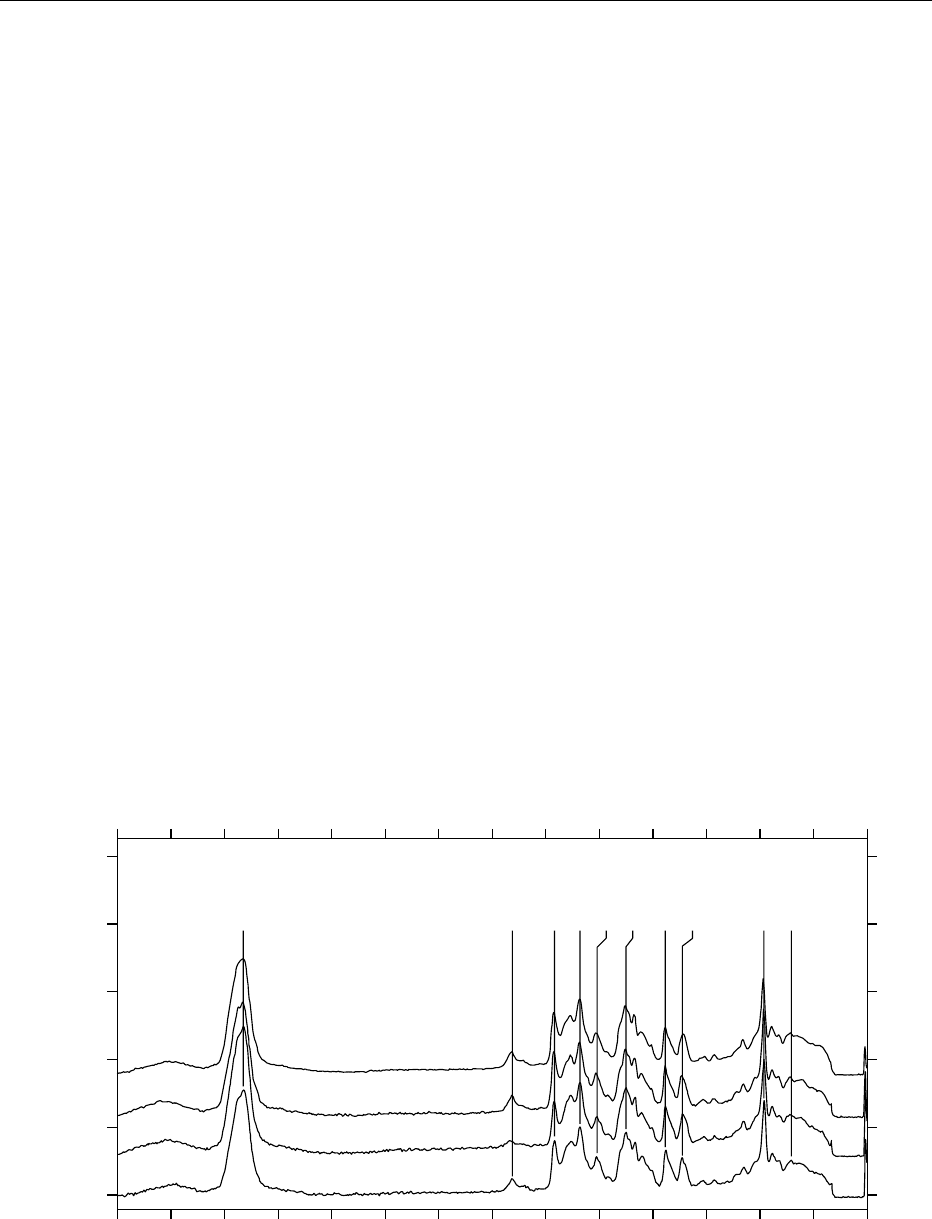
0033 Figure 8 represents typical spectra of important
food components: carbohydrates (banana), proteins
(turkey breast), and lipids (butter).
0034 Carbohydrates are poor Raman scatterers, revealing
vibrations at 2902 and 2941 cm
1
, based on their
large quantity of methine groups. The spectral range
from 1200 to 800 cm
1
is dominated by stretching
vibrations resulting from the carbon skeleton strongly
coupled with C—O bonding.
0035 Protein spectra demonstrate a stretching vibration
at 2939 cm
1
. The amide I-band, amide III-band, and
the vibrations originating from the protein backbone,
allow an analysis of the secondary protein structure
(see Table 2). The Raman spectra show specific vibra-
tions of amino acids with ring systems: phenylalan-
ine; 1607, 1003, 621 cm
1
; tyrosine 1611, 854,
829 cm
1
; tryptophan; 1556, 1424, 1356, 1009,
873, 755 cm
1
. The very strong S—S vibration in
the Raman spectrum between 540 and 520 cm
1
in
cystine is shown in Figure 3a. Cysteine shows a strong
S—H vibration at 2543 cm
1
.
0036 Lipids are dominated by strong stretching vibra-
tions of the methylene group at 2850 and
2884 cm
1
, indicating a large quantity of coupled
methylene groups. Several typical spectral features
are: the vibration of the ester group at 1744 cm
1
,
an intense bending vibration at 1440 cm
1
, a twisting
vibration at 1299 cm
1
, and vibrations of the carbon
chain between 1150 and 800 cm
1
. If unsaturated
fatty acids are present, the spectra show an additional
band, a sensitive marker of conjugation, ranging from
1655 cm
1
(C
—
—
C, cisoid form) to 1670 cm
1
(C
—
—
C,
transoid form) (Figure 9).
0037Fresh meat can be distinguished by general differ-
ences of the spectra (Figure 10).
0038Carotenes show strong vibrations in the Raman
spectrum at about 1150 and 1500 cm
1
, due to the
C
—
—
C and the C—C vibrations of the whole chain.
Since the absorption bands of carotenes are not far
from the position of the exciting line, the observed
Raman spectrum show a ‘pre-resonance’ enhance-
ment. They allow the detection of carotenes, even in
low concentrations in plant and animal cells.
0039As demonstrated in Figure 11, the Raman spectra
of fats, when the spectra are normalized to the inten-
sity of the C
—
—
O vibration, show the relative amount
of unsaturation. The spectra demonstrate the high
number of cis-substituted double bonds in safflower
and sunflower oil but demonstrate that the fat
hardening for preparing sunflower margarine reduces
the concentration of the cis bonds and enhances the
trans-substituted double bonds.
0040Figure 12 shows spectra of cheeses with different
concentration of fat in solid matter, recorded using
the original samples. The bands due to the fat and
protein content reduce their intensity with a lower
concentration, whereas the band at 3200 cm
1
, due
to water, is nearly constant.
0041Typical noodle spectra reveal the spectral feature
of starch (amylose and amylopectin) (Figure 13 and
14). The intense band at 479 cm
1
is assigned to a
C—O bending mode. The vibrations at 845 + 5cm
1
32503500 27503000
Raman units
22502500 17502000
(a)
(b)
(c)
(d)
Wavenumber (cm
−1
)
12501500 7501000 250 0
0.0
2.5
5.0
7.5
10.0
2913.3
1659.9
1459.5
1340.0
1262.9
1126.2
940.5
865.7
479.2
355.3
12.5
500
fig0013 Figure 13 Raman spectra of noodles: (a) Spa
¨
tzle; (b) Gold-Ei Landnudeln (durum wheat semolina, whole eggs 15%); (c) Bamboo
Garden Chinese Rice Noodles; (d) Reine Hartweizen-Schnittnudeln (100 % durum wheat semolina, no egg). All spectra are normalized
to the carbohydrate band at 1162 cm
1
.
5424 SPECTROSCOPY/Infrared and Raman
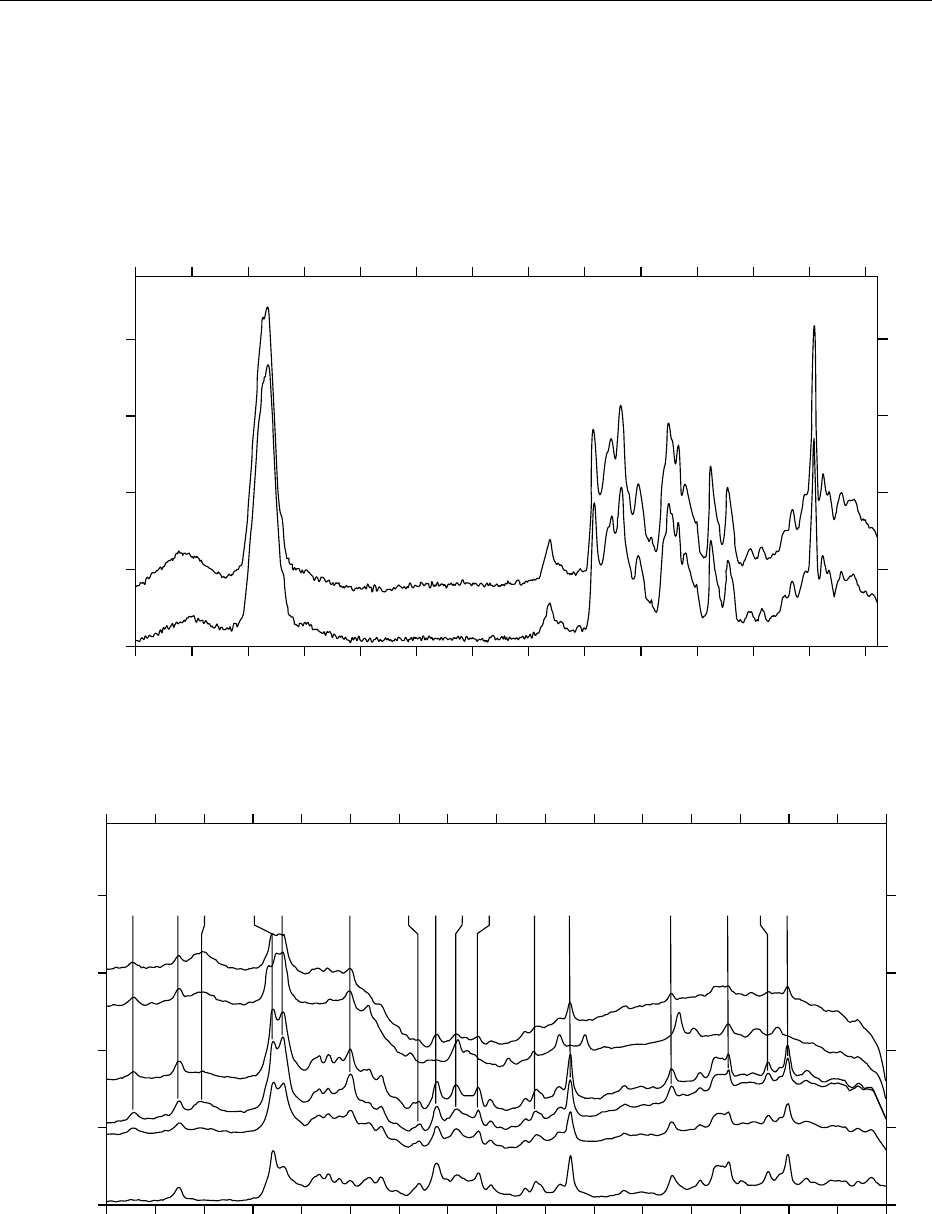
(a-anomers) and at 900 + 10cm
1
( b-anomers) are
marker bands indicating the type of configuration at
the anomeric C
1
position. However, the spectra struc-
ture correlations show that the band at 900 cm
1
is
not attributed exclusively to the b-anomeric configur-
ation. The variation in protein content can be moni-
tored by the band at 1660 cm
1
(amide I) in relation
to the band at 1459 cm
1
( d(C—H)).
0042The spectra of noodles are an example of a
nondestructive investigation of packaged food.
There are only small reductions of the intensity of
all bands visible. Food, even in glass containers, can
be investigated by Raman spectroscopy.
0043Finally, Figure 15 gives examples of food contain-
ing fat, carbohydrates and protein in different rela-
tive concentration with the typical bands already
1800
0.00
0.01
0.02
0.03
0.04
1747.5
1654.8
1606.1
1460.1
1440.9
1301.6
1160.4
1125.0
1084.0
1038.5
921.6
849.4
641.4
525.2
443.1
402.3
1700160015001400130012001100
Wavenumber (cm
−1
)
Raman Units
1000900800
(a)
(b)
(c)
(d)
(e)
(f)
700600500400300
fig00 15 Figure 15 Ramanspectraofchocolatesand marzipan:(a)SchwarzeHerrenschokolad e(Chocolatepuroextrafino),60%cocoa;(b)
chocolatefordiabetics,50%cocoa;(c)nougatchocolate,42%cocoa;(d)superiorsemibitterchocolate,55%cocoa;(e)milk
chocolate,30%cocoa;(d)marzipan.
35003250300027502500
0.0000
0.0025
0.0050
Raman units
0.0075
0.0100
2250 2000
(a)
(b)
Wavenumber (cm
−1
)
1750 1500 1250 1000 750 500 250
fig00 14 Figure 14 RamanspectraofnoodlesasinFigure10b: (a) in test tube; (b) directly through the original plastic bag.
SPECTROSCOPY/Infrared and Raman 5425

discussed. Of special interest is chocolate for diabetics
(Figure 15b with the typical bands of sucrose with
very low intensity).
See also: Amino Acids: Determination;
Chromatography: Thin-layer Chromatography; Gas
Chromatography; Fatty Acids: Analysis
Further Reading
Andreev GN, Schrader B, Schulz H, Fuchs R, Popow S and
Handjeva N (2001) Non-destructive NIR-FT-Raman
analyses in practice. Part I. Analyses of plants and his-
toric textiles. Fresenius Journal of Analytical Chemistry
371: 1009–1017.
Cao A, Liquier J and Taillandier E (1995) Infrared and
Raman spectroscopy of biomolecules. In: Schrader B
(ed.) Infrared and Raman Spectroscopy. Weinheim:
VCH Verlagsgesellschaft.
Colthup NB, Daly LH and Wiberley SE (1990) Introduc-
tion to Infrared and Raman Spectroscopy, 3rd edn.
Boston, MA: Academic Press.
Keller S, Loechte T, Dippel B and Schrader B (1993) Quality
control of food with near-infrared-excited Raman spec-
troscopy. Fresenius Journal of Analytical Chemistry 346:
863.
Kuptsov AH and Zhizhin GN (1998) Handbook of Fourier
Transform Raman and Infrared Spectra of Polymers.
Amsterdam: Elsevier.
Li-Chan ECY (1996) The applications of Raman spectros-
copy in food science. Trends in Food Science and Tech-
nology 7: 361.
Lin-Vien D, Colthup NB, Fateley WG and Grasselli JG
(1991) The Handbook of Infrared and Raman Charac-
teristic Frequencies of Organic Molecules. New York:
Academic Press.
Nakanishi K and Solomon PH (1977) Infrared Absorption
Spectroscopy, 2nd edn. Du
¨
sseldorf: Holden-Day.
Sadeghi-Jorabchi H, Wilson RH, Belton PS, Edwards-Webb
JD and Coxon DT (1991) Quantitative Analysis of Oils
and Fats by Fourier Transform Raman spectroscopy.
Spectrochimica Acta 47A: 1449.
Schrader B (1989) Raman/Infrared Atlas of Organic Com-
pounds, 2nd edn. Weinheim: VCH Verlagsgesellschaft.
Schrader B (ed.) (1995) Infrared and Raman Spectroscopy.
Methods and Applications. Weinheim: VCH Verlags-
gesellschaft.
Schrader B, Dippel B, Fendel S et al. (1998) Medical diag-
nostics with NIR-FT-Raman spectroscopy. In: Mantsch
HH and Jackson M (eds) Infrared Spectroscopy: New
Tool in Medicine. SPIE 3257, 66–71.
Schrader B, Dippel B, Erb I, Keller S, Lo
¨
chte T, Schulz H,
Tatsch E and Wessel S (1999) NIR Raman spectroscopy
in Medicine and Biology. Journal of Molecular Struc-
tures 480–481: 21.
Schrader B, Schulz H, Andreev GN, Klump HH and
Sawatzki J (2000) Non-destructive NIR-FT-Raman
spectroscopy of plants and animal tissues, of food and
works of art. Talanta 53: 35–45.
Weitkamp H and Barth R (1976) Einfu
¨
hrung in die quanti-
tative Infrarot-Spektrophotometrie. Stuttgart: Georg
Thieme Verlag.
Near-infrared
R L Wehling, University of Nebraska, Lincoln, NE, USA
Copyright 2003, Elsevier Science Ltd. All Rights Reserved.
Background
0001Near infrared (NIR) spectroscopy is a technique that is
widely used throughout the food-processing industry
for both quantitative and qualitative analysis. Typic-
ally, NIR spectroscopy measures a food’s absorption
of electromagnetic energy over a wavelength range of
800–2500 nm (12 500–4000 cm
1
). For most foods,
this results in spectra with broad, overlapping absorp-
tions that involve C—H, O—H, or N—H bonds. Since
at least one of these functional groups is found in many
of the major components of foods, information about
a wide range of constituents and quality attributes can
be extracted from NIR spectra.
0002Near infrared spectroscopy began in 1800 with an
experiment by Herschel. When he used a prism to
create a spectrum from white light and placed a therm-
ometer at a point just beyond the red region of the
spectrum, he noted an increase in temperature. This
was the first observation of the effects of NIR radi-
ation. Between 1920 and 1945, many of the absorp-
tion bands observed in the NIR spectra of organic
compounds were assigned to specific chemical func-
tional groups. By the 1940s, NIR spectroscopy was
being used in the chemical industry for applications
such as the determination of water in organic liquids.
0003Modern NIR spectroscopy applied to foods and
agricultural commodities established its foundations
in the 1960s and 1970s. Karl Norris and colleagues at
the Beltsville, MD laboratory of the United States
Department of Agriculture (USDA) developed suc-
cessful methods for obtaining NIR reflectance spectra
from solid biological samples such as leaves, fruit, or
cereal grains. In their work developing a rapid method
for moisture determination, they also coupled NIR
spectroscopy with computer-based multivariate stat-
istical techniques that helped to eliminate interference
from absorptions of other constituents (protein, fat,
carbohydrate) on the moisture determination. Ultim-
ately, the use of such correlational techniques allowed
the measurement of these other constituents, as well.
0004The first commercial NIR instruments specifically
designed for analysis of foods and agricultural
5426 SPECTROSCOPY/Near-infrared
